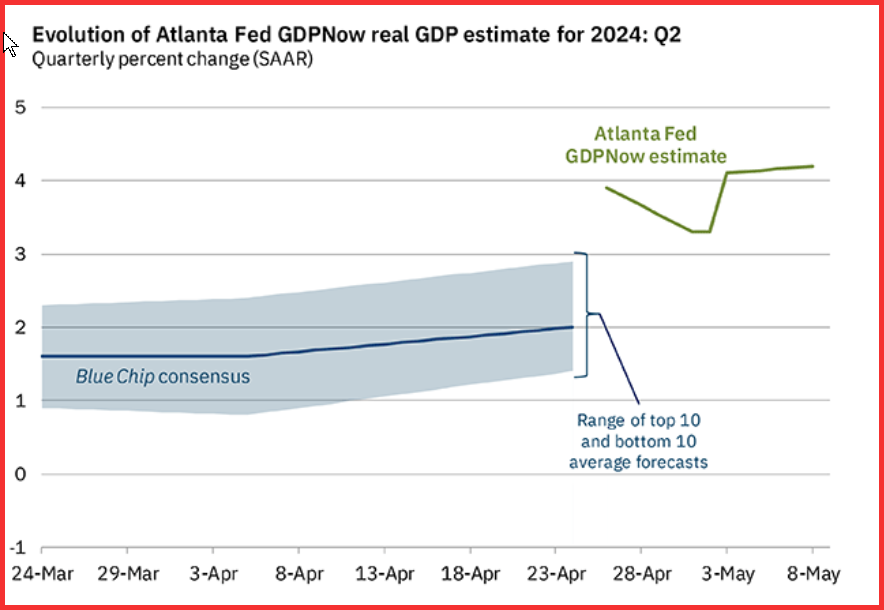Outlook
We get the usual jobless claims today, ho hum. Now that the Bank of England has spoken, attention will turn to next week’s CPI (May 15th) and the ECB. The FT has commented several times about how inflation in the US differs from inflation in the eurozone. The IMF takes the stance “… virtually all the US upward price pressures since inflation peaked come from a labour market that is ‘too’ strong. In the Eurozone, it’s entirely a story of outside shocks and their propagation.”
Well, no. When you put the data on the same measurement bases, the US and eurozone have remarkably similar numbers. So the “divergence” story is a crock, at least when it comes to inflation and its underlying causes.
The same cannot be said about economic growth. Some observers were unhappy when the Atlanta Fed reports the latest GDPNow for Q2 up yesterday to a whopping 4.2% (from 3.3% on May 2). The contrast with the eurozone could not be stronger. From recession/near recession over the past two years, eurozone growth is running at 0.4% q/q and will be lucky to hit 1% for the year. Granted, there are wild differences among the member countries, with the former losers (Greece, Spain, Italy) getting the better number and the former winners struggling (Germany, France).
But the point is that the ECB needs a rate cut to goose growth while the US needs to keep rates on hold to rein in exuberance. So while some may want to suggest the Fed is only a month or two behind the UK and ECB with cuts in June, the growth numbers contradict that scenario.
Should we not consider the others will wait for the Fed? Yeah, maybe. If so, a key reason, although hardly anyone will want to say so out loud, is that the ECB rate cut in June dooms the euro to further declines.
Forecast: The pullback is continuing and perhaps gathering steam. As noted above, a central factor is the expectation of a June rate cut by the ECB that policy members have been promoting for some time, while the Fed stands pat and the differential widens. In addition, the messy Middle East prods some to go for the safe-haven dollar.
We might also add that despite some courts allowing Trump to postpone meeting the law until after the election, the one actual trial we do have is going very badly for him and his conduct shows him in an unfavorable light—e.g., swearing out loud at a witness. The so-called base is not influenced but pundits are betting that the very large “undecided” demographic is leaning away, if not actually running.
Intervention saga
We asked a real expert on BoJ intervention whether it’s a rumor or true, and what’s next? Here is part of the reply: “BOJ intervention tactics haven't changed in all these years (and they eventually work so why change?).” Some of the intervention story is actual “covert” intervention and some is whispers. The Japanese attitude: “Why make it public?”
The expert nailed it! This is exactly the attitude we have seen for decades. It’s sophisticated and probably saves a lot of reserve money—one or two small purchases and several whispers to get the machine rolling.
Reasons for the Fed to cut rates
Avoid embarrassment from getting inflation wrong twice.
Normalize the yield curve.
Head off any recessionary tendencies.
Help housing via mortgage rates.
Help banks rollover commercial property loans.
Help the stock market.
Synchronize with the ECB (and Riksbank and SNB).
(Help the current White House).
This is an excerpt from “The Rockefeller Morning Briefing,” which is far larger (about 10 pages). The Briefing has been published every day for over 25 years and represents experienced analysis and insight. The report offers deep background and is not intended to guide FX trading. Rockefeller produces other reports (in spot and futures) for trading purposes.
To get a two-week trial of the full reports plus traders advice for only $3.95. Click here!
This morning FX briefing is an information service, not a trading system. All trade recommendations are included in the afternoon report.
Recommended Content
Editors’ Picks
EUR/USD turns sideways below 1.0900 ahead of Fedspeak

EUR/USD is trading sideways below 1.0900 in European trading on Monday, despite a risk-on market mood. The pair, however, finds support from the struggling US Dollar and sluggish US Treasury bond yields, awaiting Fedspeak amid light European trading.
Gold price consolidates near $2,450, fresh record highs

Gold price holds its upbeat momentum intact on Monday, sitting at fresh record highs of $2,450 in the European session. The bright metal benefits from renewed hopes for Fed rate cuts and renewed geopolitical tensions surrounding Iran. Fedspeak is next on tap.
GBP/USD holds steady near 1.2700, Fedspeak in focus

GBP/USD is off the highs, consolidating near 1.2700 in the European trading hours on Monday. A subdued US Dollar supports the pair amid moderate risk appetite. Traders stay cautious on potential geopolitical escalation in Iran and ahead of Fedspeak.
Ripple stays above $0.50 on Monday as firm backs research on blockchain and quantum computing

XRP price holds steady above the $0.50 key support level and edges higher on Monday, trading at 0.5130 and rising 0.70% in the day at the time of writing.
Week ahead: Nvidia results and UK CPI falling back to target

What a week for investors. The Dow Jones reached a record high and closed last week above 40,000, for the first time ever. This is a major bullish signal even though gains for global stocks were fairly modest on Friday, and European stocks closed lower.

